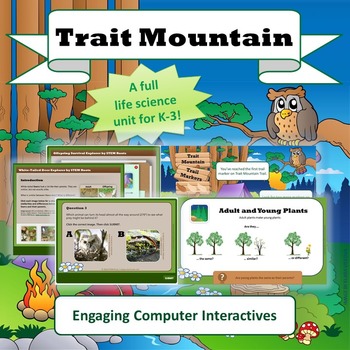NGSS Life Science "Trait Mountain" STEM Unit (Traits|Heredity|Biomimicry) |1-LS
- Zip
Also included in
- This bundle contains five immersive lesson plans plus an eventual engineering bonus pack aligned to the Next Generation Science Standard for first grade. Each lesson plan includes complete lesson plan instructions, interactive PowerPoint presentations, corresponding e-learning activity, labs, workshPrice $42.36Original Price $52.95Save $10.59
- Expand Trait Mountain Lesson 3 (aligned to NGSS 1-LS1-1). The original lesson includes 6 Biomimicry Discovery Cards from the Temperate Forest biome of Trait Mountain. This expansion bundles an additional 42 Biomimicry Discovery Cards from 7 additional biomes to SAVE!!★★ View myBiomimicry Discovery CPrice $34.19Original Price $37.99Save $3.80
- This bundle is my best value for NGSS first grade. It contains an five immersive lesson plans aligned to the Next Generation Science Standard for first grade--plus all eight of my Biomimicry Discovery Cards (48 cards/8 biomes).ABOUT THE BIOMIMICRY DISCOVERY CARD KIT EXPANSION:Expand Trait MountainPrice $64.76Original Price $80.95Save $16.19
Description
Traits, heredity, survival and biomimicry: flora and fauna abound in Trait Mountain.
Follow Trait Mountain Trail and discover the life science behind traits, survival and biomimicry on your way to the summit in this three-week unit!
DEMO
View demo (with intro screens and a few sample interactions only) here.
★ For a quick peek at part of Lesson 3, check out myBiomimicry Discovery Cards Demo.★
Three weeks’ worth of lesson plans are aligned to the first-grade Next Generation Science Standards for life science and are appropriate for K-4.
✿ Lesson One: Parents and Offspring
Through class presentations, interactive multimedia explorers and hands-on labs, students will discover that offsping plants and animals are similar to--but not exactly like--their parents.
The class will use an interactive Douglas Fir Tree explorer to discover the similiarites and differences between parent and offspring Douglas Fir trees. They will then examine several parent and offspring plants in a hands-on labs and record their observations in their Plants and Their Offspring Lab Journal.
A second interactive, White-tailed Deer Explorer, allows the class to observe the similarities and differences between parent and offspring white-tailed deer. Students then use photos and readings in an Animals and Their Offspring Lab Journal to make observations about parent and offspring Trait Mountain fauna--bears, owls, turtles, newts and trout.
The unit finishes with the introduction of the Trait Mountain Trail Marker System when students meet the first trail marker. Teachers can opt to provide a class picnic once students reach Trait Mountain Summit as an incentive for completing the unit.
✿ Lesson Two: Protecting Young
In this unit, students discover three survival requirements--food, water and shelter--and how parents and animals exhibit survival behaviors to protect their young through the interactive Trait Mountain Survival Guide and Worksheet.
Students then create a Trait Mountain Patchwork Landscape Art STEAM Project. Students learn basic principles for sketching a landscape scene and apply an American folk art style to coloring their work--all while integrating the three survival elements.
An Offspring Survival Explorer and Group Research Project caps off this unit. Students collaborate in groups to report on offspring survival traits of bears, owls, turtles, newts or trout--and present their findings to the class in a group oral report.
✿ Lesson Three: Physical Survival and Biomimicry
Scientists study plants and animals traits to discover new technology to solve human problems.
In this lesson, students play the interactive "What's If For?" Game to discover how physical traits help plants and animals survive.
Then, they discover four origami Biomimicry Discovery Cards that, through visual and written clues, reveal biomimicry inventions based on birds (flight), cat eyes (reflectors), burrs (Velcro), and bat ears (radar).
This lesson culminates with students inventing their own potential biomimicry discoveries and designing their own Biomimicry Discovery Cards with visual and written clues using a provided template.
TRAIT MOUNTAIN BUNDLES WITH BIOMIMICRY DISCOVERY CARD EXPANSIONS:
• NGSS Grade 1 Bundle: Complete STEM Curriculum
RELATED PRODUCTS
• Bundle: Biomes Biomimicry Discovery Cards Kits
• Desert Biome Biomimicry Discovery Cards Kit
• Freshwater Biome Biomimicry Discovery Cards Kit
• Grasslands Biome Biomimicry Discovery Cards Kit
• Marine Waters Biome Biomimicry Discovery Cards Kit
• Taiga Biome Biomimicry Discovery Cards Kit
• Temperate Forest Biome Biomimicry Discovery Cards Kit (Included in Trait Mountain.)
• Tropical Rainforests Biome Biomimicry Discovery Cards Kit
• Tundra Biome Biomimicry Discovery Cards Kit
Lesson plans combine a series of:
• engaging hands-on activities
• observation labs
• writing exercises
• art and engineering projects
• computer interactives
Click the included link or scan the included QR code to run the online version. Or unzip the provided files to run the course locally (some screens don't function fully on the local version). This course is versatile enough to be used:
• On any computer with a classroom projector
• With a smart whiteboard (or interactive flipchart)
• On a PC in a homeschool setting
This is an excellent way to incorporate life science into your lesson plans!
★ Follow me! Click the star (★) beneath my STEM Roots store name above to be the first to know about freebies, new product listings and more!
! Terms of Use: This product gives the End User (purchaser) the right to use the lesson plans in their classroom. Please purchase one additional, discounted multi-seat license per classroom if sharing with additional classrooms or for school district use. Thank you!
All projects are aligned to Common Core State Standards (CCSS) and Next Generation Science Standards (NGSS). See preview file for lesson overview and standards alignment.
Keywords: offspring, survival, physical traits, survival traits, food, water, shelter, deer, forest, habitat, biomimicry, mimic nature, copy nature, inventions, origami, STEAM, STEM, Heather Galler, patchwork, NGSS 1-LS3-1, NGSS 1.LS3.1, NGSS 1-LS1-2, NGSS 1.LS1.2, NGSS 1-LS1-1, NGSS 1.LS1.1.








